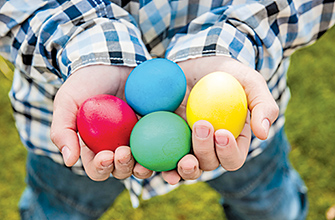Easter is one of the most important days of the year for Christians. Easter Sunday is filled with symbolism and tradition, some of which harken back to early Christianity, while others trace their origins to paganism.
The Easter Bunny and Easter eggs are two Easter traditions with less extensive histories. The Easter Bunny, according to sources including History.com, first arrived in America in the 1700s via German settlers who brought with them their tradition of an egg-laying hare called “Osterhase.” Children would make nests where the rabbit could lay its colored eggs. Eventually, the custom spread from Pennsylvania, where many German immigrants settled, to other areas around the country.
Eggs are symbolic of new life and rebirth in many cultures. To Christians, eggs represent the resurrection of Jesus Christ.
Another theory suggests that Christians were once forbidden to eat during the Lenten season preceding Easter. Therefore, Christians would paint and decorate eggs for Easter to mark the joyous celebration and cessation of penance and fasting.
Even though these traditions have endured, Easter eggs themselves might not be so strong. This year, Easter celebrants may want to experiment with different materials that are more forgiving and more enduring than standard eggs.
Wooden eggs
Families may find that wooden eggs are much more forgiving than standard eggs. Wooden eggs don’t have to be boiled, and they don’t need time to harden, and they’re quite maneuverable for young fingers.
Decorators can explore different ways to color wooden eggs. Acrylic paints are readily available and safe for users of any age. Wood stains or wood markers also can be used to give the eggs a natural finish. Others may want to rip small pieces of decorative paper to create a decoupage effect on their wooden eggs.
Sew soft eggs
Those who are handy with a needle and thread can explore patterns for making soft, stuffed eggs. Cozy fleece or other fabrics can be sewn together to make the general egg shape. Then the egg is filled with polyester filling, feathers or another soft material. Ribbons, buttons, trims, and other decorative touches can personalize the eggs and add a touch of whimsy. Check out http://www.sew4home.com for their ideas on handmade Easter eggs.
Modeling clay
Children who love to get their hands dirty may enjoy making Easter eggs out of modeling materials. Colors can be blended together to create a marbleized effect. Depending on the clay medium, the eggs may air-harden or may need to be heated at a low temperature in the oven to fully cure.
Easter eggs are a fun tradition that adds to the festivity of spring. While traditional eggs can be used, many different, more long-lasting materials can be used as well.





Leave a Comment
Your email address will not be published. Required fields are marked with *